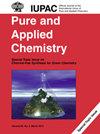钐在 1,3-二甲基-2-咪唑烷酮溶剂中的电沉积特性
IF 2
4区 化学
Q3 CHEMISTRY, MULTIDISCIPLINARY
引用次数: 0
摘要
本研究探讨了 Sm(III) 的电化学光谱以及金属钐在中性配体离子液体(溶解离子液体)中的电沉积。混合物包括溶解离子液体 1.3-二甲基-2-咪唑烷酮(DMI)中的钐前体(三水合钐或六水合硝酸钐)。Sm(III)-DMI 电解质的傅立叶变换红外光谱分析表明,Sm3+ 离子通过羰基(C=O)与 DMI 配位;三盐酸盐溶液和硝酸盐溶液的光谱带一分为二,分别在 1630 cm-1 和 1649 cm-1 出现了新的峰值。拉曼光谱也证实了 Sm(III)通过羰基的氧原子与 DMI 溶合。Sm(III) 离子的伏安特性表明,Sm(III)/Sm(II) 在约 -2.0 V 和 Sm(II) 在约 -2.0 V 的电压下有两步还原机制。-与 Ag.对于两种含钐(III)的电解质,Sm(III)/Sm(II)和Sm(II)/Sm(0)分别在-3.0 V和-3.0 V与Ag/Ag+发生反应。在三盐酸盐和硝酸盐电解质中,Sm(III) 的扩散系数值分别为 2.185 × 10-6 cm2/s 和 2.418 × 10-8 cm2/s。使用铜基板作为工作电极,通过恒电位电解实现了钐的电沉积,在三盐酸盐-DMI 电解质中产生了紧凑的沉积物,而在硝酸盐-DMI 电解质中产生了不均匀的颗粒状沉积物。对沉积样品进行的原位 X 射线光电子能谱分析表明,金属钐(1081 eV)与其氧化物形式(1083 eV)共存。本文章由计算机程序翻译,如有差异,请以英文原文为准。
Electrodeposition behaviour of samarium in 1,3-dimethyl-2-imidazolidone solvent
The present study investigates the electrochemistry spectroscopy of Sm(III), and electrodeposition of samarium metal in neutral ligand-based ionic liquid (solvate ionic liquid). Mixture consisted of a samarium precursor (either samarium triflate or samarium nitrate hexahydrate) in the solvate ionic liquid, 1.3-dimethyl-2-imidazolidone (DMI). FT-IR analysis of Sm(III)-DMI electrolytes indicates that Sm3+ ion coordinates with DMI through carbonyl group (C=O); the band splits into two with emergence of new peak at 1630 cm−1 and 1649 cm−1 for the triflate and nitrate solutions, respectively. Raman spectroscopy also confirms the solvation of Sm(III) with DMI through oxygen atom of the carbonyl group. Voltametric behaviour of Sm(III) ion indicates two-step reduction mechanism via Sm(III)/Sm(II) at ca. −2.0 V and Sm(II)/Sm(0) at ca. −3.0 V vs. Ag/Ag+ for both samarium(III)-containing electrolytes. Diffusion coefficient value of Sm(III) was determined to be 2.185 × 10−6 cm2 /s and 2.418 × 10−8 cm2 /s for triflate and nitrate electrolytes, respectively. Electrodeposition of samarium was achieved through constant potential electrolysis using copper substrate as the working electrode which yielded compact deposits from triflate-DMI and non-uniform granular deposit from nitrate-DMI electrolyte. Ex situ X-ray photoelectron spectroscopy analysis of the as-deposited samples revealed the presence of metallic Sm (1081 eV) co-existing with its oxide form (1083 eV).
求助全文
通过发布文献求助,成功后即可免费获取论文全文。
去求助
来源期刊

Pure and Applied Chemistry
化学-化学综合
CiteScore
4.00
自引率
0.00%
发文量
60
审稿时长
3-8 weeks
期刊介绍:
Pure and Applied Chemistry is the official monthly Journal of IUPAC, with responsibility for publishing works arising from those international scientific events and projects that are sponsored and undertaken by the Union. The policy is to publish highly topical and credible works at the forefront of all aspects of pure and applied chemistry, and the attendant goal is to promote widespread acceptance of the Journal as an authoritative and indispensable holding in academic and institutional libraries.
 求助内容:
求助内容: 应助结果提醒方式:
应助结果提醒方式:


